What is ASO and why is it extremely necessary for today's developers
- From the sandbox
- Tutorial
This is the first article in a series of materials that I plan to devote to the promotion of mobile applications using ASO and localization. Therefore, first of all, I would like to explain what ASO is, what components it consists of, what it is inherently connected with and why it is so necessary. In the future, based on my experience (and, accordingly, the experience of the company in which I work), I will gladly tell you how to use these tools most effectively, what results to expect in the long and short term, I will give you an algorithm of actions and share useful resources that help reduce time on ASO activities.
But let's start with the basics. Every mobile application developer wants his product to be successful. Success can be measured in different ways (the number of downloads and active users, ratings and user reviews, etc.), but we all understand that one of the most important indicators of success is payback, and then the profitability of the whole thing. So, what do the numbers tell us: in 2012, the global market for mobile applications amounted to approximately 7.83 billion dollars. The Russian segment of the mobile applications market, according to various estimates, reached 120-160 million dollars in 2012, and continued to grow by 11 in the first quarter of 2013 % There are good news and bad news in these wonderful numbers. It is good that the Russian-speaking market is growing. This means that you and I have where to turn around, there is an active audience, ready to download applications and use them. Thanks to this audience, we can improve our products and make them as beautiful as possible. And the second news is that in order to be really successful and to earn a lot, you and I need to leave the zone of Russian-speaking comfort and develop international markets. And this is not bad at all. It is interesting, it is, as our English-speaking friends say, challenging.
And a couple of words about the global application market.
According to Flurry, which you see in the pretty diagram below, the largest number of iOS and Android devices are concentrated in the USA and China, and Britain is in third place.
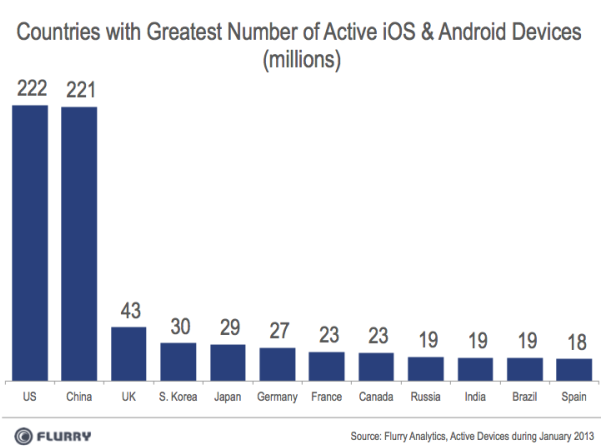
This means that localizing the application in only 2 languages (English and Chinese) will add you almost 500 million potential users.
Now let's look not at the number of devices, but at the volumes of profit in these markets:
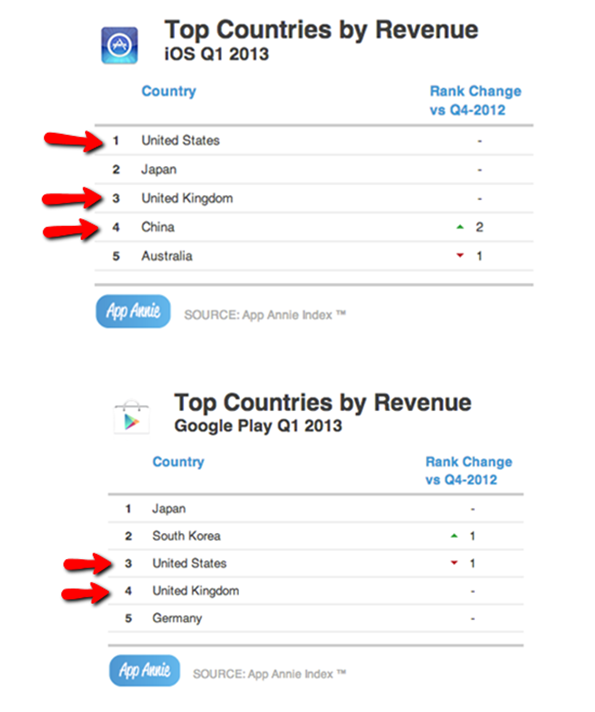
Let's analyze the data a bit.
The US is the undisputed leader in the AppStore, with very fierce competition.
Japan is a promising market if you like your application there. (A small secret to the success of monetization in the Japanese Google zone. Play - debiting funds from the operator’s mobile account, and not from a credit card)
China - the main profit will come to you from the AppStore. In many Chinese forums, you can download the apk of your paid application literally the day after it appears on Google.Play.
And here we come back to 500 million potential Anglo-Chinese users. Even if a fifth of these users buy something from you for $ 1, and the market takes another 30%, the amount is still pretty impressive.
Let me leave you for a moment to make you dream.
Well, if this is not enough for you, here are the data on the fastest growing mobile device markets. These areas and languages are quite promising for themselves, and in most of them there is less competition than in the US mobile application market.
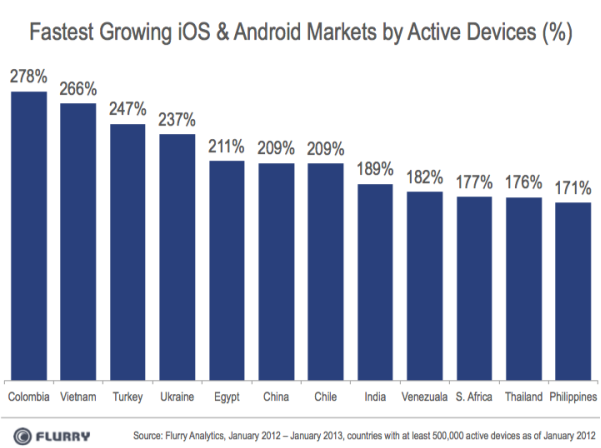
And one more good news for the independent developers that we are. Pay attention to the diagram below. On it, we can observe a positive upward trend in revenue for independent and small developers whose games and applications occupy a position lower than a hundredth, but whose income, however, is 68% of the income of all mobile publishers.
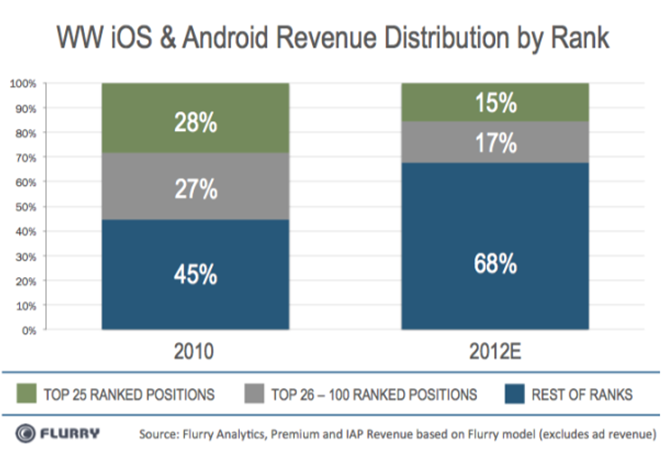
This means that if you are really good, you will feel it in monetary terms. Well, in case of financial failure, you will have one less excuse.
So, let's go back to ASO, that is, AppStore Optimization, which many loudly call the new SEO. Now I will try, in my own words, to explain what it is and why it is so necessary. Today, the AppStore has more than 800 thousand applications. Updating the AppStore interface (now search results are displayed not in a list, but in large blocks with an icon, screenshot and top line of description), together with an imperfect search system, make our application invisible to potential users, and ASO will help us to get out of this situation.
What does this mysterious ASO include and why is it so effective. AppStore Optimization is a complex of measures. Here both the icon and screenshots are important, as well as the name of both the application itself and the publisher, in addition, keywords hidden from users play a huge role here. And do not forget about user reviews and their number, the number of external links to your application, the number of applications from the publisher and their quality, as well as many, many other things that affect your rating and position when searching.
I will allow myself another very interesting schedule, so that you add confidence that not everything is lost.
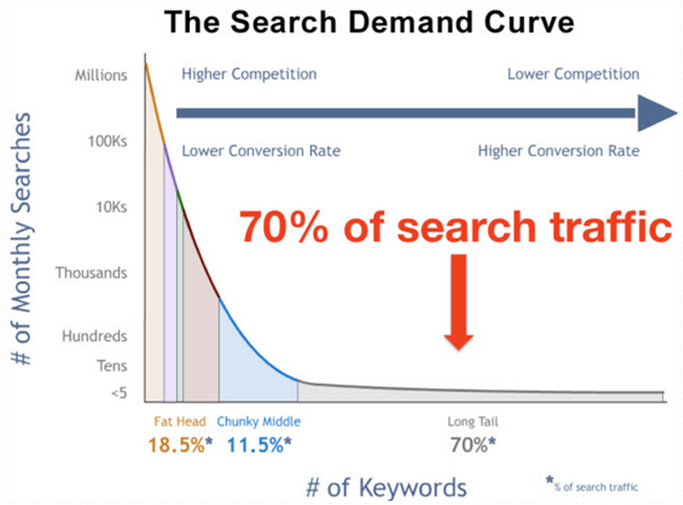
So what we see here. Almost 20% of searches are “trivial,” in the thousands and millions. Try entering in the search game (about 160 thousand results), travel (23 thousand), camera (12 thousand), news (15 thousand), shopping (3 thousand). Of course, no one will look at a thousand applications in search of yours (do not forget that the more downloads and positive reviews the application has, the higher it appears in the search results and there is no place for new applications here). Now, let's look at the chart again. 70% of searches are rare words or combinations of words, long or specialized queries. Thus, one of the basics of ASO is the right keywords that will take you to the first position in a specialized search.
It should be noted that the selection of narrow and successful keywords is mainly applicable to the AppStore. In Google.Play, everything is different, the description text is indexed there, unlike the AppStore, and the keyword string hidden from users is missing. However, I plan to devote a separate article to keywords in the AppStore, Google.Play and Amazon.
The ASO theme is incredibly extensive, and I plan to continue sharing it with you.
In the meantime, I’ll give you some ASO “newbie” errors that will help you today:
• When listing keywords in the AppStore, use only commas, no spaces!
• Do not come up with a name from nonexistent words. Ideally, the name of the application should contain at least one keyword. This will significantly increase the chances of the application being found.
• Do not put text on the icon. This is definitely superfluous.
• The first screenshot should be as informative as possible, so it’s best to put the “gameplay” or the main functions of the application there. Do not be the first to put a menu or a splash screen.
• Be sure to localize screenshots! This is a must!
• The most important application in the description is the first line. Make it as informative as possible.
• The description of the application in the AppStore is not indexed for search, so do not stuff it with keywords.
• It will be useful to put in the description of the rewards that the application received, or good user reviews. It works.
• Recently, you can’t use asterisks and check marks in the description on the AppStore (★ ✓), but you can still be creative in the description.
• Changing keywords in the AppStore is only possible with updating the application. But you should not do the update just because of this. Apple guys may not like this.
• In the end, study your competitors! See what they do well, and maybe get it together.
• Use the services appstorerankings.net , searchman.com and other similar ones to find successful keywords and track competitors, but do not forget to double-check their work.
• Localize your applications, their descriptions and keywords, if you have not done so before.
I look forward to your feedback and comments, I urge you to share experiences and practical tips. For my part, I am always ready to give advice or advice. Thanks.
Based on materials:
blog.flurry.com
blog.appannie.com/category/app-annie-index
But let's start with the basics. Every mobile application developer wants his product to be successful. Success can be measured in different ways (the number of downloads and active users, ratings and user reviews, etc.), but we all understand that one of the most important indicators of success is payback, and then the profitability of the whole thing. So, what do the numbers tell us: in 2012, the global market for mobile applications amounted to approximately 7.83 billion dollars. The Russian segment of the mobile applications market, according to various estimates, reached 120-160 million dollars in 2012, and continued to grow by 11 in the first quarter of 2013 % There are good news and bad news in these wonderful numbers. It is good that the Russian-speaking market is growing. This means that you and I have where to turn around, there is an active audience, ready to download applications and use them. Thanks to this audience, we can improve our products and make them as beautiful as possible. And the second news is that in order to be really successful and to earn a lot, you and I need to leave the zone of Russian-speaking comfort and develop international markets. And this is not bad at all. It is interesting, it is, as our English-speaking friends say, challenging.
And a couple of words about the global application market.
According to Flurry, which you see in the pretty diagram below, the largest number of iOS and Android devices are concentrated in the USA and China, and Britain is in third place.

This means that localizing the application in only 2 languages (English and Chinese) will add you almost 500 million potential users.
Now let's look not at the number of devices, but at the volumes of profit in these markets:

Let's analyze the data a bit.
The US is the undisputed leader in the AppStore, with very fierce competition.
Japan is a promising market if you like your application there. (A small secret to the success of monetization in the Japanese Google zone. Play - debiting funds from the operator’s mobile account, and not from a credit card)
China - the main profit will come to you from the AppStore. In many Chinese forums, you can download the apk of your paid application literally the day after it appears on Google.Play.
And here we come back to 500 million potential Anglo-Chinese users. Even if a fifth of these users buy something from you for $ 1, and the market takes another 30%, the amount is still pretty impressive.
Let me leave you for a moment to make you dream.
Well, if this is not enough for you, here are the data on the fastest growing mobile device markets. These areas and languages are quite promising for themselves, and in most of them there is less competition than in the US mobile application market.

And one more good news for the independent developers that we are. Pay attention to the diagram below. On it, we can observe a positive upward trend in revenue for independent and small developers whose games and applications occupy a position lower than a hundredth, but whose income, however, is 68% of the income of all mobile publishers.

This means that if you are really good, you will feel it in monetary terms. Well, in case of financial failure, you will have one less excuse.
So, let's go back to ASO, that is, AppStore Optimization, which many loudly call the new SEO. Now I will try, in my own words, to explain what it is and why it is so necessary. Today, the AppStore has more than 800 thousand applications. Updating the AppStore interface (now search results are displayed not in a list, but in large blocks with an icon, screenshot and top line of description), together with an imperfect search system, make our application invisible to potential users, and ASO will help us to get out of this situation.
What does this mysterious ASO include and why is it so effective. AppStore Optimization is a complex of measures. Here both the icon and screenshots are important, as well as the name of both the application itself and the publisher, in addition, keywords hidden from users play a huge role here. And do not forget about user reviews and their number, the number of external links to your application, the number of applications from the publisher and their quality, as well as many, many other things that affect your rating and position when searching.
I will allow myself another very interesting schedule, so that you add confidence that not everything is lost.

So what we see here. Almost 20% of searches are “trivial,” in the thousands and millions. Try entering in the search game (about 160 thousand results), travel (23 thousand), camera (12 thousand), news (15 thousand), shopping (3 thousand). Of course, no one will look at a thousand applications in search of yours (do not forget that the more downloads and positive reviews the application has, the higher it appears in the search results and there is no place for new applications here). Now, let's look at the chart again. 70% of searches are rare words or combinations of words, long or specialized queries. Thus, one of the basics of ASO is the right keywords that will take you to the first position in a specialized search.
It should be noted that the selection of narrow and successful keywords is mainly applicable to the AppStore. In Google.Play, everything is different, the description text is indexed there, unlike the AppStore, and the keyword string hidden from users is missing. However, I plan to devote a separate article to keywords in the AppStore, Google.Play and Amazon.
The ASO theme is incredibly extensive, and I plan to continue sharing it with you.
In the meantime, I’ll give you some ASO “newbie” errors that will help you today:
• When listing keywords in the AppStore, use only commas, no spaces!
• Do not come up with a name from nonexistent words. Ideally, the name of the application should contain at least one keyword. This will significantly increase the chances of the application being found.
• Do not put text on the icon. This is definitely superfluous.
• The first screenshot should be as informative as possible, so it’s best to put the “gameplay” or the main functions of the application there. Do not be the first to put a menu or a splash screen.
• Be sure to localize screenshots! This is a must!
• The most important application in the description is the first line. Make it as informative as possible.
• The description of the application in the AppStore is not indexed for search, so do not stuff it with keywords.
• It will be useful to put in the description of the rewards that the application received, or good user reviews. It works.
• Recently, you can’t use asterisks and check marks in the description on the AppStore (★ ✓), but you can still be creative in the description.
• Changing keywords in the AppStore is only possible with updating the application. But you should not do the update just because of this. Apple guys may not like this.
• In the end, study your competitors! See what they do well, and maybe get it together.
• Use the services appstorerankings.net , searchman.com and other similar ones to find successful keywords and track competitors, but do not forget to double-check their work.
• Localize your applications, their descriptions and keywords, if you have not done so before.
I look forward to your feedback and comments, I urge you to share experiences and practical tips. For my part, I am always ready to give advice or advice. Thanks.
Based on materials:
blog.flurry.com
blog.appannie.com/category/app-annie-index
